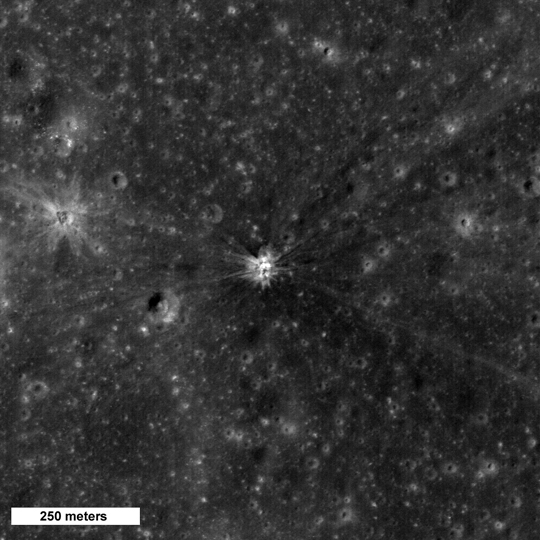[/caption]
Speaking of lunar impacts: While we await the science data from the LCROSS mission impact earlier this morning, the Lunar Reconnaissance Orbiter team has released this image of another impact on the Moon 38 years ago . The crater in the center of this image was formed by Apollo 14’s Saturn IVB booster. The booster was intentionally impacted into the lunar surface on Feb. 4, 1971. The impact caused a minor “moonquake” that scientists used to learn about the moon’s interior structure. Seismometers placed on the surface by the Apollo 12 astronauts returned data on the tremor.
The crater is about 35 meters (115 feet). The interior of the crater has bright mounds, and a bright ejecta blanket surrounds the exterior of the crater. Bright rays are observed to extend across the surface for more than 1.5 km (0.9 miles) from the impact. This LROC image was taken when the sun was relatively high in the sky, bringing out subtle differences in reflectivity or brightness. This site has been observed before, and scientists noted the unusual occurrence of dark and bright rays when the Apollo 16 spacecraft observed the site.
Comparing the Apollo booster impact to LCROSS, the Apollo impact velocity was at 9,144 kph (5,682 mph.) The booster component weighed 14,000 kg (30,835 lbs) at the time of impact, and the impact energy was equivalent to just over 10 tons of TNT. A seismometer placed in 1969 by Apollo 12 astronauts recorded the vibrations, which lasted for about three hours. The LCROSS impactor (the upper stage of a Centaur rocket) is much smaller than the S-IVB and thus will make a smaller crater. The Centaur weighs about 2000 kg (4,409 lbs) and will hit with a velocity of about 9,000 kph (5,592 mph.)
So anyone worried about the LCROSS impact; don’t worry, the Moon has seen much worse from earlier impacts — both intentional by humans and the unintentional consequences of being in a space-dust and -debris filled region of space.
Source: NASA


Looks like the LCROSS crash is going to be a bit more mysterious.
LRO slowly but surely has become one of my favorite (current) missions. Of course it will never edge out Cassini or the MER rovers OR MRO as ‘all time favorites’, but hopefully will continue to provide crystal clear lunar details for use in the near future.
I’m all over finding sub surface volcanic tubes to use for habitat. I THINK finding them should become a priority – to search for ‘ready made’ or easily enhanced hardened shelter(s)
Wait a minute.. does that mean, to go to the Moon, we have to first go back to ‘the caves’? LOL!
There was such an uproar about us “bombing” the moon, that it’s good to read about this other, historical impact.
One small correction – while the conversion from kg to lbs. applies on Earth, on the surface of the moon, gravity is about 1/6 of Earth’s. While it might help Americans understand the relative size of these objects, it is best to just refer to their masses in kilograms. They just don’t weigh as much when they hit the moon’s surface.